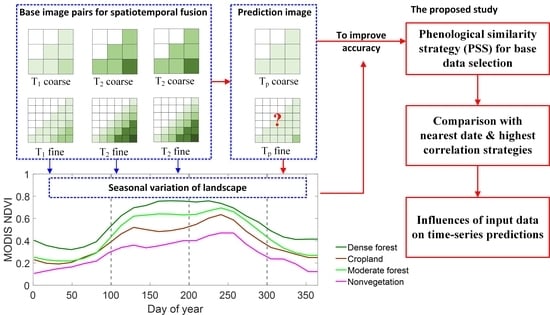Assessing the Accuracy of Landsat-MODIS NDVI Fusion with Limited Input Data: A Strategy for Base Data Selection
Abstract
1. Introduction
- (1)
- (2)
- (3)
- Fused NDVI products can characterize the vegetation phenology.
- (4)
- The results derived from this approach provide a reference for fusing multiband reflectances or other land surface parameters.
2. Materials and Methods
2.1. Study Site and Data
2.2. Fusion Algorithms Tested
2.3. Phenological Similarity Strategy (PSS) for Base Data Selection
2.4. Applying Fusion Algorithms
2.5. Applying Fusion Strategies
2.6. Quantifying the Temporal Distribution of Input Image Pairs
3. Results
3.1. Validity of the Phenological Similarity Strategy (PSS)
3.1.1. Time Interval vs. Fusion Accuracy
3.1.2. MODIS Correlation vs. Fusion Accuracy
3.1.3. PSS Weight vs. Image Similarity
3.1.4. PSS Weight vs. Fusion Accuracy
3.2. Comparison of Different Strategies for Base Data Selection
3.3. Influence of Input Data on the Fusion Accuracy
4. Discussion
5. Conclusions
- (1)
- The base-prediction time interval has a nonlinear and complex relationship with the fusion accuracy using the ESTARFM and LMGM algorithms. Hence, the base-prediction time interval alone cannot explain the changes in fusion accuracy. The MODIS correlation has a linear relationship with, but is not a good indicator of the fusion accuracy due to its narrow value range. In contrast, the PSS weight has a wider range of 0~1 or 0~1.5 corresponding to cases involving one or two image pairs, respectively. We found a strong linear correlation between the PSS weight and actual Landsat image similarity (R = 0.925), which is much higher than the correlation between the MODIS image similarity and Landsat image similarity (R = 0.877). This confirms that the PSS readily captures the similarity between fine images on different dates and can serve as a good indicator for base data selection in spatiotemporal fusion algorithms.
- (2)
- The PSS achieves higher accuracy than the NDS and HCS in the ESTARFM and LMGM algorithms. For the ESTARFM algorithm, the predictability of the image pairs selected by the PSS is better than that of the pairs selected by the NDS and HCS. For the LMGM algorithm, using one image pair yields a higher accuracy than using two image pairs for both the NDS and the HCS. In general, LMGM-PSS produces systematically higher accuracies than LMGM-NDS-1, LMGM-NDS-2, LMGM-HCS-1, and LMGM-HCS-2, indicating that LMGM-PSS could combine the complementary strength of using one and two image pairs. Furthermore, LMGM-PSS is very flexible and can automatically determine whether to use one or two image pairs for a prediction date.
- (3)
- In the cases involving very limited input data, the timing of the base image pairs is much more important than the absolute number of base image pairs on the fusion accuracy using the PSS. Even with very limited data (Nin = 2), spatiotemporal data fusion could be highly accurate given appropriate temporal distribution patterns. An increase in the number of base image pairs does not necessarily improve the fusion accuracy, but including an additional image pair at a dissimilar phenological stage can significantly enhance the accuracy of year-round predictions. In general, base data that adequately cover the four phenological stages are more likely to produce a high fusion accuracy.
Author Contributions
Funding
Institutional Review Board Statement
Informed Consent Statement
Data Availability Statement
Acknowledgments
Conflicts of Interest
References
- Emelyanova, I.V.; McVicar, T.R.; Van Niel, T.G.; Li, L.T.; Van Dijk, A.I.J.M. Assessing the accuracy of blending Landsat–MODIS surface reflectances in two landscapes with contrasting spatial and temporal dynamics: A framework for algorithm selection. Remote Sens. Environ. 2013, 133, 193–209. [Google Scholar] [CrossRef]
- Gevaert, C.M.; García-Haro, F.J. A comparison of STARFM and an unmixing-based algorithm for Landsat and MODIS data fusion. Remote Sens. Environ. 2015, 156, 34–44. [Google Scholar] [CrossRef]
- Gao, F.; Masek, J.; Schwaller, M.; Hall, F. On the blending of the Landsat and MODIS surface reflectance: Predicting daily Landsat surface reflectance. IEEE Trans. Geosci. Remote Sens. 2006, 44, 2207–2218. [Google Scholar] [CrossRef]
- Zhu, X.; Cai, F.; Tian, J.; Williams, T.K.A. Spatiotemporal Fusion of Multisource Remote Sensing Data: Literature Survey, Taxonomy, Principles, Applications, and Future Directions. Remote Sens. 2018, 10, 527. [Google Scholar] [CrossRef]
- Hilker, T.; Wulder, M.A.; Coops, N.C.; Seitz, N.; White, J.C.; Gao, F.; Masek, J.G.; Stenhouse, G. Generation of dense time series synthetic Landsat data through data blending with MODIS using a spatial and temporal adaptive reflectance fusion model. Remote Sens. Environ. 2009, 113, 1988–1999. [Google Scholar] [CrossRef]
- Zhu, X.; Jin, C.; Feng, G.; Chen, X.; Masek, J.G. An enhanced spatial and temporal adaptive reflectance fusion model for complex heterogeneous regions. Remote Sens. Environ. 2010, 114, 2610–2623. [Google Scholar] [CrossRef]
- Wang, P.; Gao, F.; Masek, J.G. Operational Data Fusion Framework for Building Frequent Landsat-Like Imagery. IEEE Trans. Geosci. Remote Sens. 2014, 52, 7353–7365. [Google Scholar] [CrossRef]
- Cui, J.; Xin, Z.; Luo, M. Combining Linear Pixel Unmixing and STARFM for Spatiotemporal Fusion of Gaofen-1 Wide Field of View Imagery and MODIS Imagery. Remote Sens. 2018, 10, 1047. [Google Scholar] [CrossRef]
- Xie, D.; Zhang, J.; Zhu, X.; Pan, Y.; Liu, H.; Yuan, Z.; Yun, Y. An Improved STARFM with Help of an Unmixing-Based Method to Generate High Spatial and Temporal Resolution Remote Sensing Data in Complex Heterogeneous Regions. Sensors 2016, 16, 207. [Google Scholar] [CrossRef]
- Amorós-López, J.; Gómez-Chova, L.; Alonso, L.; Guanter, L.; Zurita-Milla, R.; Moreno, J.; Camps-Valls, G. Multitemporal fusion of Landsat/TM and ENVISAT/MERIS for crop monitoring. Int. J. Appl. Earth Obs. Geoinf. 2013, 23, 132–141. [Google Scholar] [CrossRef]
- Zurita-Milla, R.; Clevers, J.G.P.W.; Schaepman, M.E. Unmixing-Based Landsat TM and MERIS FR Data Fusion. IEEE Geosci. Remote Sens. Lett. 2008, 5, 453–457. [Google Scholar] [CrossRef]
- Zurita-Milla, R.; Gómez-Chova, L.; Guanter, L.; Clevers, J.G.P.W.; Camps-Valls, G. Multitemporal Unmixing of Medium-Spatial-Resolution Satellite Images: A Case Study Using MERIS Images for Land-Cover Mapping. IEEE Trans. Geosci. Remote Sens. 2011, 49, 4308–4317. [Google Scholar] [CrossRef]
- Zurita-Milla, R.; Kaiser, G.; Clevers, J.G.P.W.; Schneider, W.; Schaepman, M.E. Downscaling time series of MERIS full resolution data to monitor vegetation seasonal dynamics. Remote Sens. Environ. 2009, 113, 1874–1885. [Google Scholar] [CrossRef]
- Xue, J.; Leung, Y.; Fung, T. A Bayesian Data Fusion Approach to Spatio-Temporal Fusion of Remotely Sensed Images. Remote Sens. 2017, 9, 1310. [Google Scholar] [CrossRef]
- Song, H.; Huang, B. Spatiotemporal Satellite Image Fusion through One-Pair Image Learning. IEEE Trans. Geosci. Remote Sens. 2013, 51, 1883–1896. [Google Scholar] [CrossRef]
- Song, H.; Liu, Q.; Wang, G.; Hang, R.; Huang, B. Spatiotemporal Satellite Image Fusion Using Deep Convolutional Neural Networks. IEEE J. Sel. Top. Appl. Earth Obs. Remote Sens. 2018, 11, 1–9. [Google Scholar] [CrossRef]
- Wei, J.; Wang, L.; Liu, P.; Song, W. Spatiotemporal Fusion of Remote Sensing Images with Structural Sparsity and Semi-Coupled Dictionary Learning. Remote Sens. 2016, 9, 21. [Google Scholar] [CrossRef]
- Bo, P.; Meng, Y.; Su, F. An Enhanced Linear Spatio-Temporal Fusion Method for Blending Landsat and MODIS Data to Synthesize Landsat-Like Imagery. Remote Sens. 2018, 10, 881. [Google Scholar] [CrossRef]
- Zhu, X.L.; Helmer, E.H.; Gao, F.; Liu, D.S.; Chen, J.; Lefsky, M.A. A flexible spatiotemporal method for fusing satellite images with different resolutions. Remote Sens. Environ. 2016, 172, 165–177. [Google Scholar] [CrossRef]
- Chen, Y.; Cao, R.Y.; Chen, J.; Zhu, X.L.; Zhou, J.; Wang, G.P.; Shen, M.G.; Chen, X.H.; Yang, W. A New Cross-Fusion Method to Automatically Determine the Optimal Input Image Pairs for NDVI Spatiotemporal Data Fusion. IEEE Trans. Geosci. Remote Sens. 2020, 58, 5179–5194. [Google Scholar] [CrossRef]
- Xie, D.; Gao, F.; Sun, L.; Anderson, M. Improving Spatial-Temporal Data Fusion by Choosing Optimal Input Image Pairs. Remote Sens. 2018, 10, 1142. [Google Scholar] [CrossRef]
- Olexa, E.M.; Lawrence, R.L. Performance and effects of land cover type on synthetic surface reflectance data and NDVI estimates for assessment and monitoring of semi-arid rangeland. Int. J. Appl. Earth Obs. Geoinf. 2014, 30, 30–41. [Google Scholar] [CrossRef]
- Liu, M.; Yang, W.; Zhu, X.L.; Chen, J.; Chen, X.H.; Yang, L.Q.; Helmer, E.H. An Improved Flexible Spatiotemporal DAta Fusion (IFSDAF) method for producing high spatiotemporal resolution normalized difference vegetation index time series. Remote Sens. Environ. 2019, 227, 74–89. [Google Scholar] [CrossRef]
- Ju, J.; Roy, D.P. The availability of cloud-free Landsat ETM+ data over the conterminous United States and globally. Remote Sens. Environ. 2008, 112, 1196–1211. [Google Scholar] [CrossRef]
- Wang, Y.; Xie, D.; Liu, S.; Hu, R.; Li, Y.; Yan, G. Scaling of FAPAR from the Field to the Satellite. Remote Sens. 2016, 8, 310. [Google Scholar] [CrossRef]
- Wang, Y.; Xie, D.; Li, X. Universal scaling methodology in remote sensing science by constructing geographic trend surface. J. Remote Sens. 2014, 18, 1139–1146. (in Chinese). [Google Scholar]
- Wang, Y.; Yan, G.; Hu, R.; Xie, D.; Chen, W. A Scaling-Based Method for the Rapid Retrieval of FPAR from Fine-Resolution Satellite Data in the Remote-Sensing Trend-Surface Framework. IEEE Trans. Geosci. Remote Sens. 2020, 58, 7035–7048. [Google Scholar] [CrossRef]
- Rao, Y.; Zhu, X.; Chen, J.; Wang, J. An Improved Method for Producing High Spatial-Resolution NDVI Time Series Datasets with Multi-Temporal MODIS NDVI Data and Landsat TM/ETM+ Images. Remote Sens. 2015, 7, 7865–7891. [Google Scholar] [CrossRef]
- Hu, S.; Mo, X.; Lin, Z. Optimizing the photosynthetic parameter Vcmax by assimilating MODIS-fPAR and MODIS-NDVI with a process-based ecosystem model. Agric. For. Meteorol. 2014, 198-199, 320–334. [Google Scholar] [CrossRef]
- Gamon, J.A.; Huemmrich, K.F.; Stone, R.S.; Tweedie, C.E. Spatial and temporal variation in primary productivity (NDVI) of coastal Alaskan tundra: Decreased vegetation growth following earlier snowmelt. Remote Sens. Environ. 2013, 129, 144–153. [Google Scholar] [CrossRef]
- Meng, J.; Du, X.; Wu, B. Generation of high spatial and temporal resolution NDVI and its application in crop biomass estimation. Int. J. Digit. Earth 2013, 6, 203–218. [Google Scholar] [CrossRef]
- Jarihani, A.A.; McVicar, T.R.; Niel, T.G.V.; Emelyanova, I.V.; Callow, J.N.; Johansen, K. Blending Landsat and MODIS Data to Generate Multispectral Indices: A Comparison of “Index-then-Blend” and “Blend-then-Index” Approaches. Remote Sens. 2014, 6, 9213–9238. [Google Scholar] [CrossRef]
- Tian, F.; Wang, Y.; Fensholt, R.; Wang, K.; Zhang, L.; Huang, Y. Mapping and Evaluation of NDVI Trends from Synthetic Time Series Obtained by Blending Landsat and MODIS Data around a Coalfield on the Loess Plateau. Remote Sens. 2013, 5, 4255–4279. [Google Scholar] [CrossRef]
- Chen, X.H.; Liu, M.; Zhu, X.L.; Chen, J.; Zhong, Y.F.; Cao, X. “Blend-then-Index” or “Index-then-Blend”: A Theoretical Analysis for Generating High-resolution NDVI Time Series by STARFM. Photogramm. Eng. Remote Sens. 2018, 84, 66–74. [Google Scholar] [CrossRef]
- Wulder, M.A.; Loveland, T.R.; Roy, D.P.; Crawford, C.J.; Masek, J.G.; Woodcock, C.E.; Allen, R.G.; Anderson, M.C.; Belward, A.S.; Cohen, W.B.; et al. Current status of Landsat program, science, and applications. Remote Sens. Environ. 2019, 225, 127–147. [Google Scholar] [CrossRef]
- Markham, B.L.; Storey, J.C.; Williams, D.L.; Irons, J.R. Landsat sensor performance: History and current status. IEEE Trans. Geosci. Remote Sens. 2004, 42, 2691–2694. [Google Scholar] [CrossRef]
- Vermote, E.; Justice, C.; Claverie, M.; Franch, B. Preliminary analysis of the performance of the Landsat 8/OLI land surface reflectance product. Remote Sens. Environ. 2016, 185, 46–56. [Google Scholar] [CrossRef]
- Zhang, X.; Wang, J.; Gao, F.; Liu, Y.; Schaaf, C.; Friedl, M.; Yu, Y.; Jayavelu, S.; Gray, J.; Liu, L. Exploration of scaling effects on coarse resolution land surface phenology. Remote Sens. Environ. 2017, 190, 318–330. [Google Scholar] [CrossRef]
- Walker, J.J.; De Beurs, K.M.; Wynne, R.H.; Gao, F. Evaluation of Landsat and MODIS data fusion products for analysis of dryland forest phenology. Remote Sens. Environ. 2012, 117, 381–393. [Google Scholar] [CrossRef]
- Gao, F.; Anderson, M.C.; Zhang, X.; Yang, Z.; Alfieri, J.G.; Kustas, W.P.; Mueller, R.; Johnson, D.M.; Prueger, J.H. Toward mapping crop progress at field scales through fusion of Landsat and MODIS imagery. Remote Sens. Environ. 2017, 188, 9–25. [Google Scholar] [CrossRef]
- Gao, F.; He, T.; Masek, J.G.; Shuai, Y.; Schaaf, C.; Wang, Z. Angular Effects and Correction for Medium Resolution Sensors to Support Crop Monitoring. IEEE J. Sel. Top. Appl. Earth Obs. Remote Sens. 2014, 7, 4480–4489. [Google Scholar] [CrossRef]

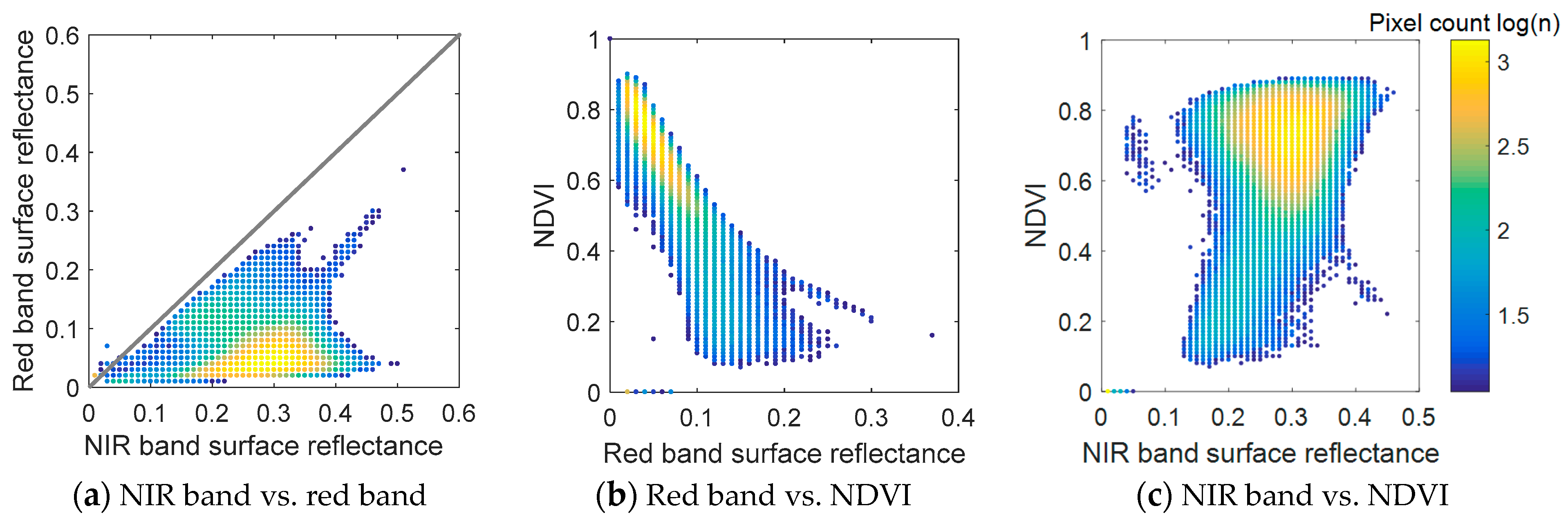
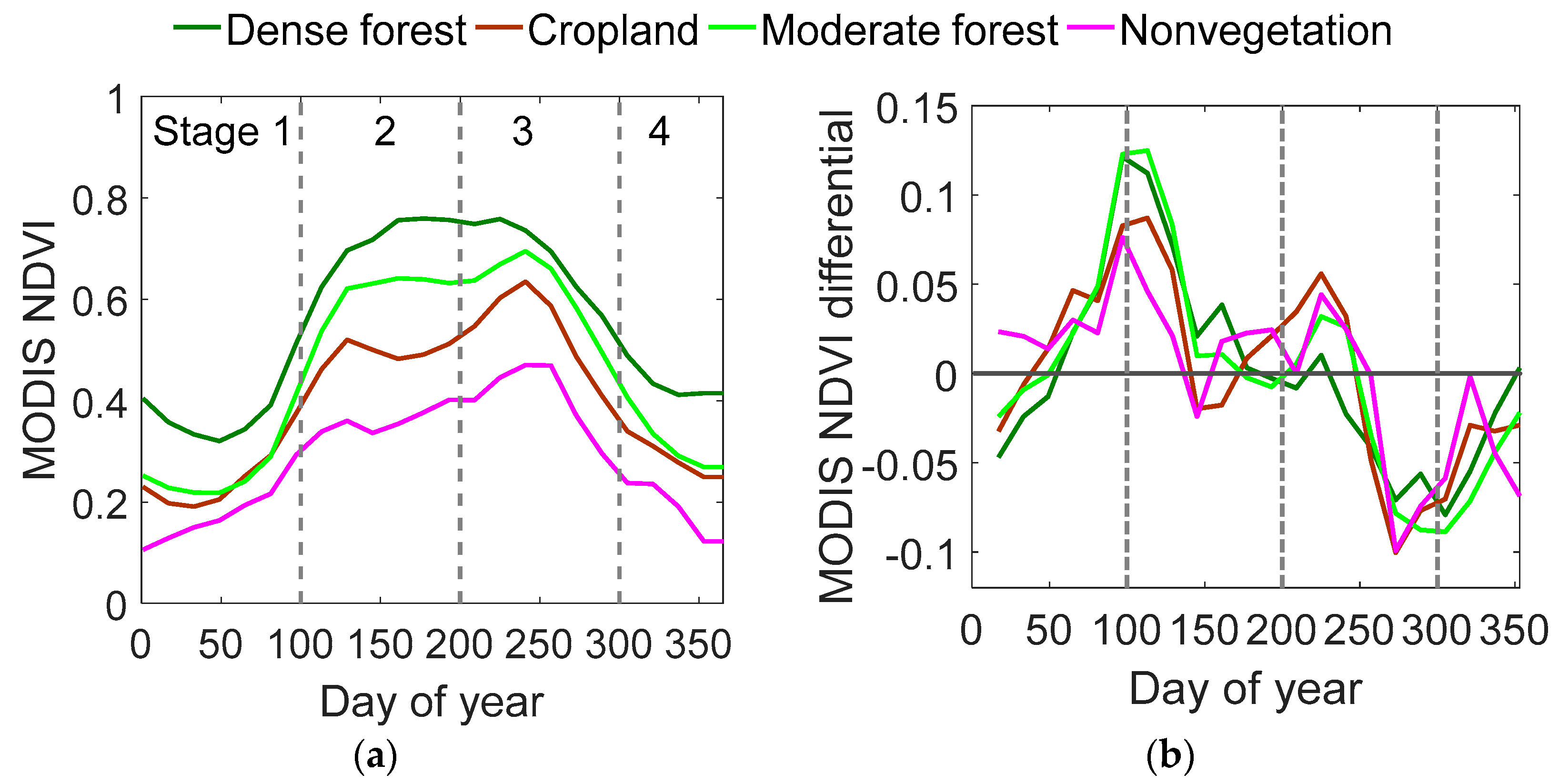
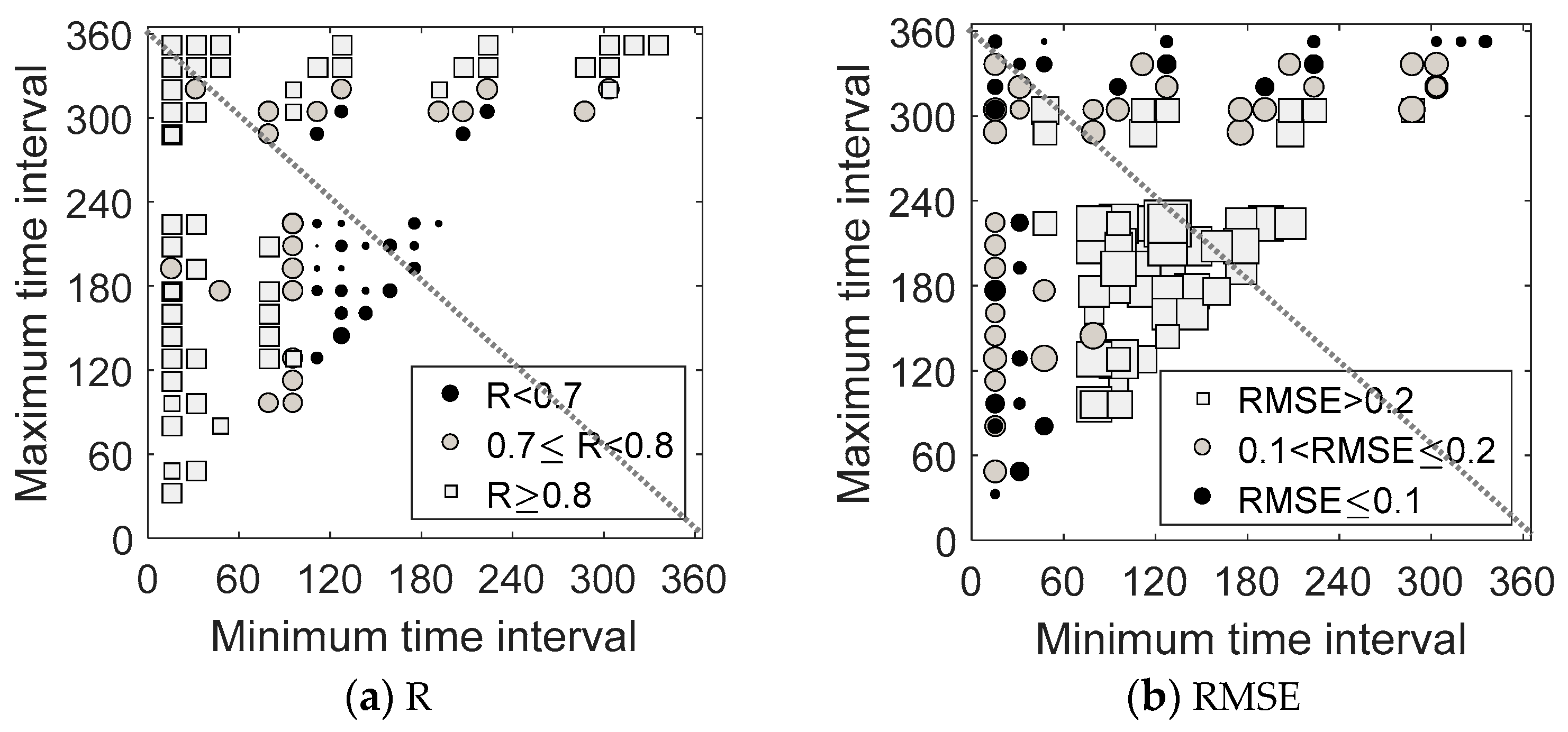
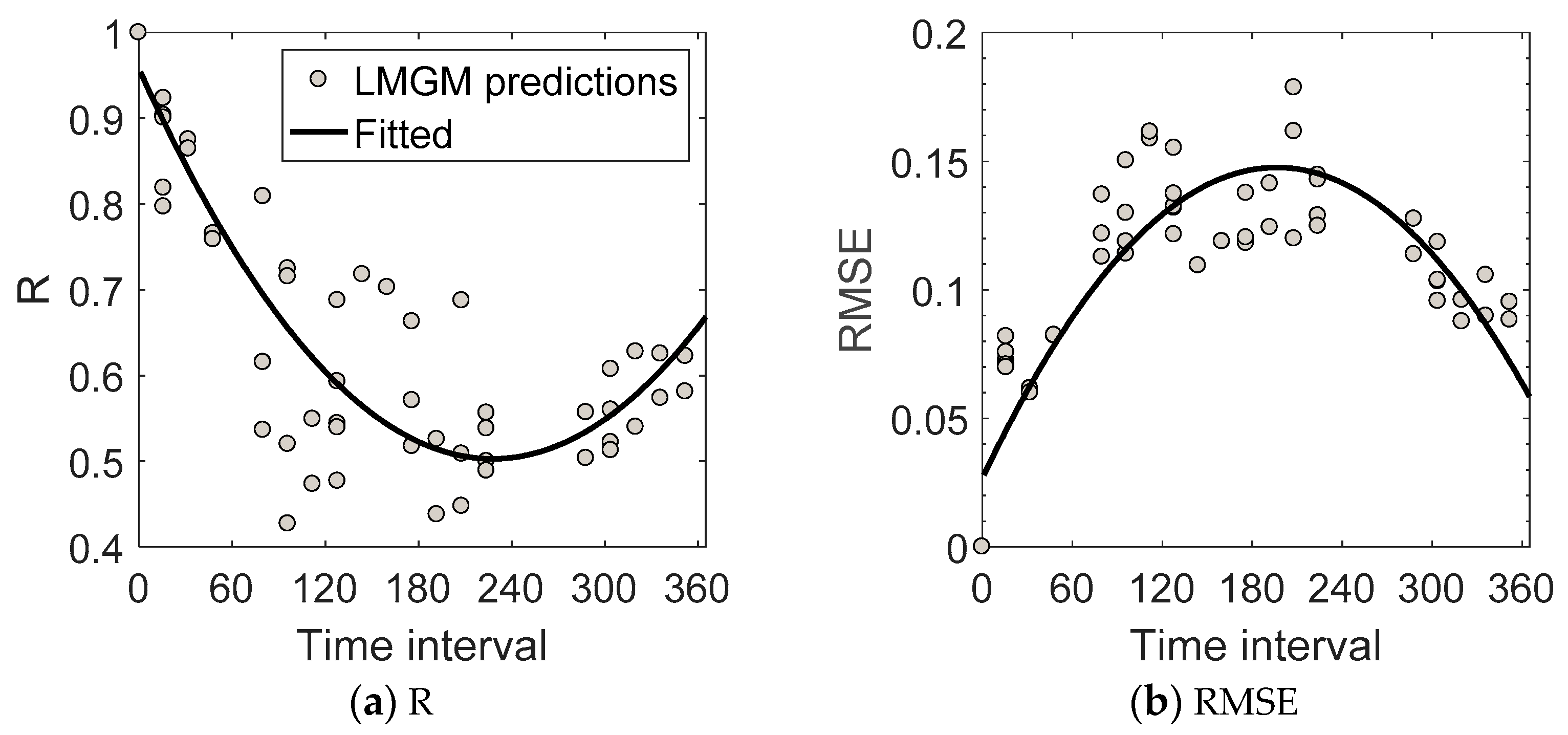
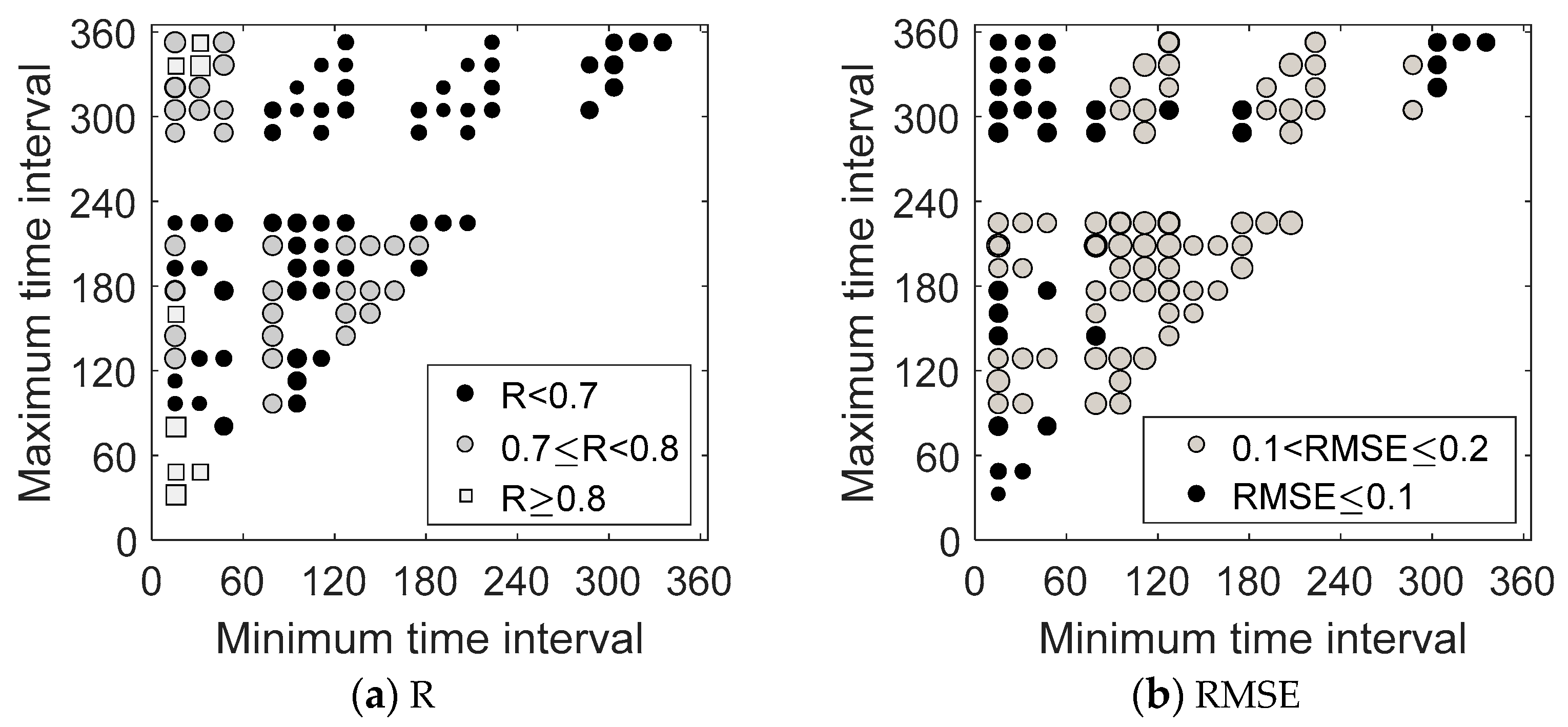
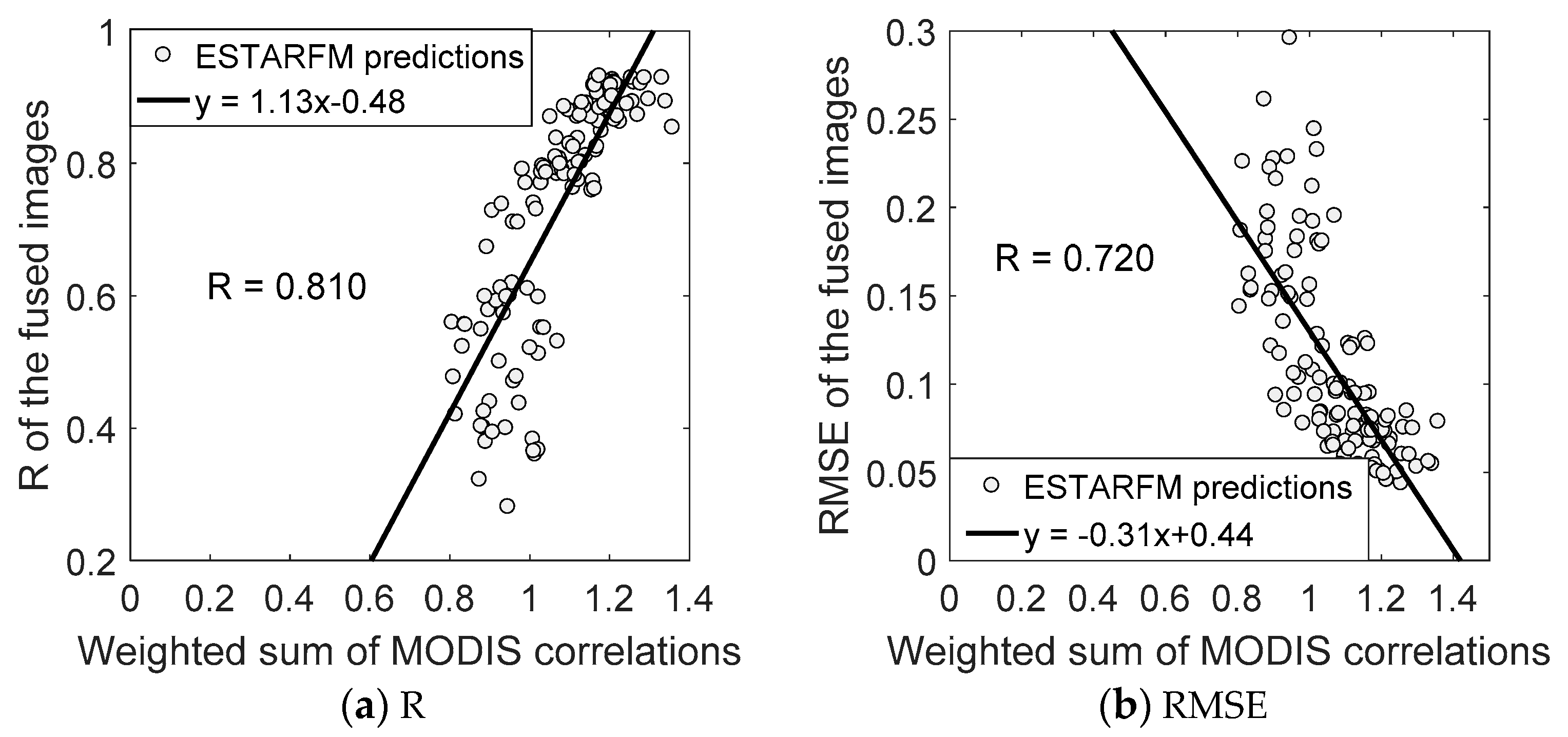
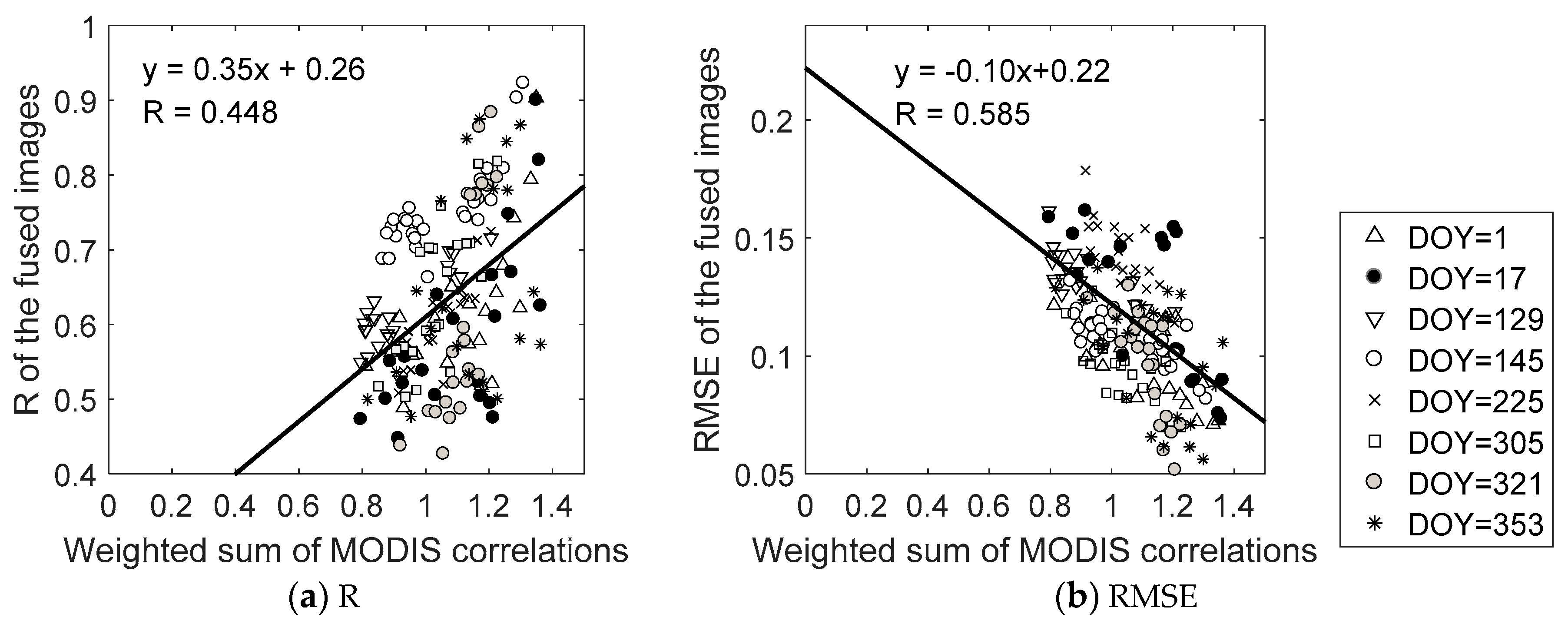
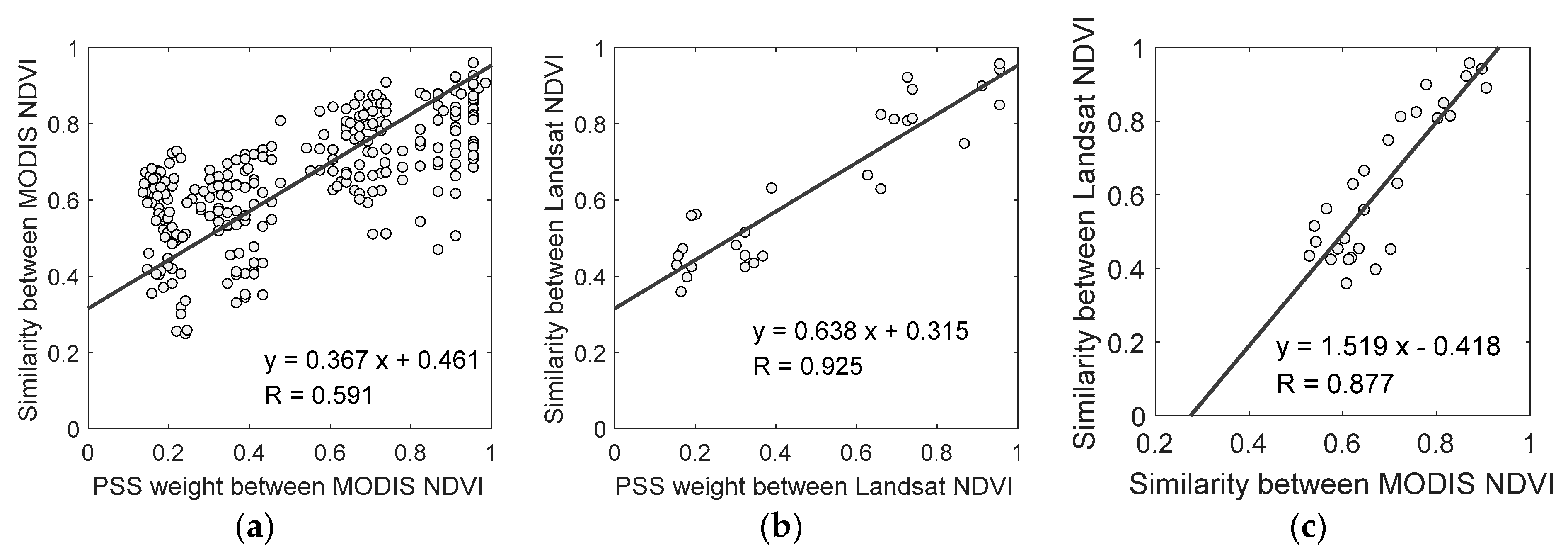
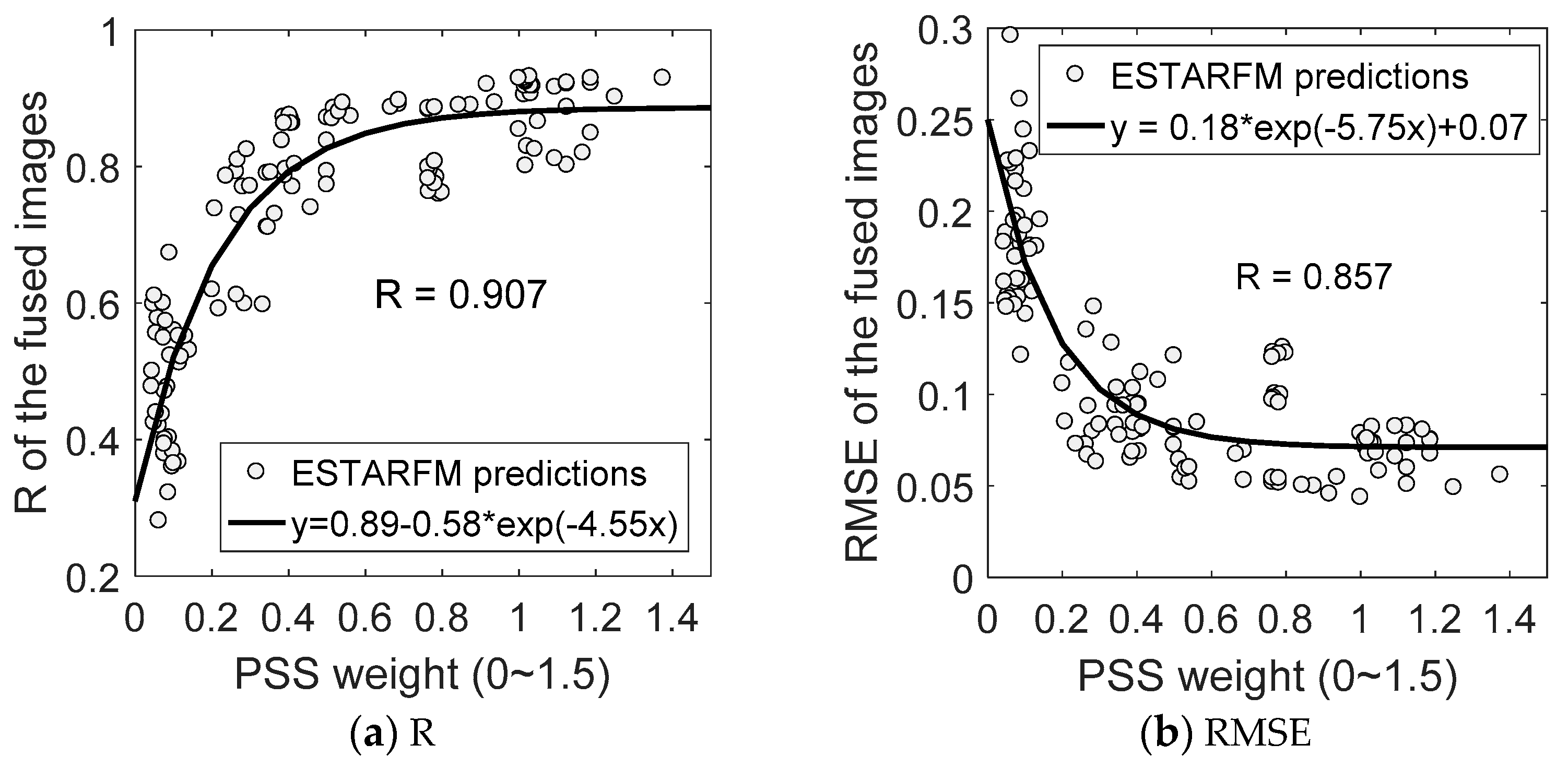
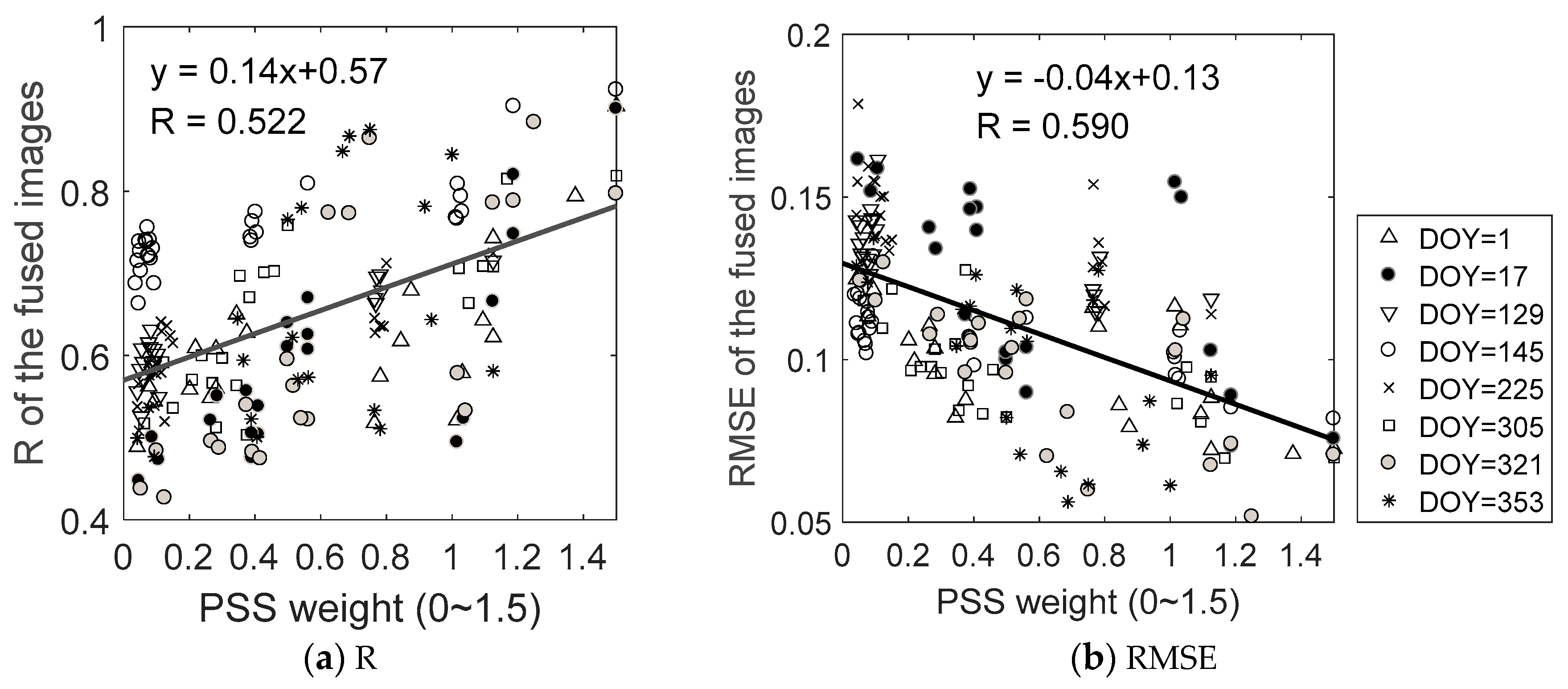
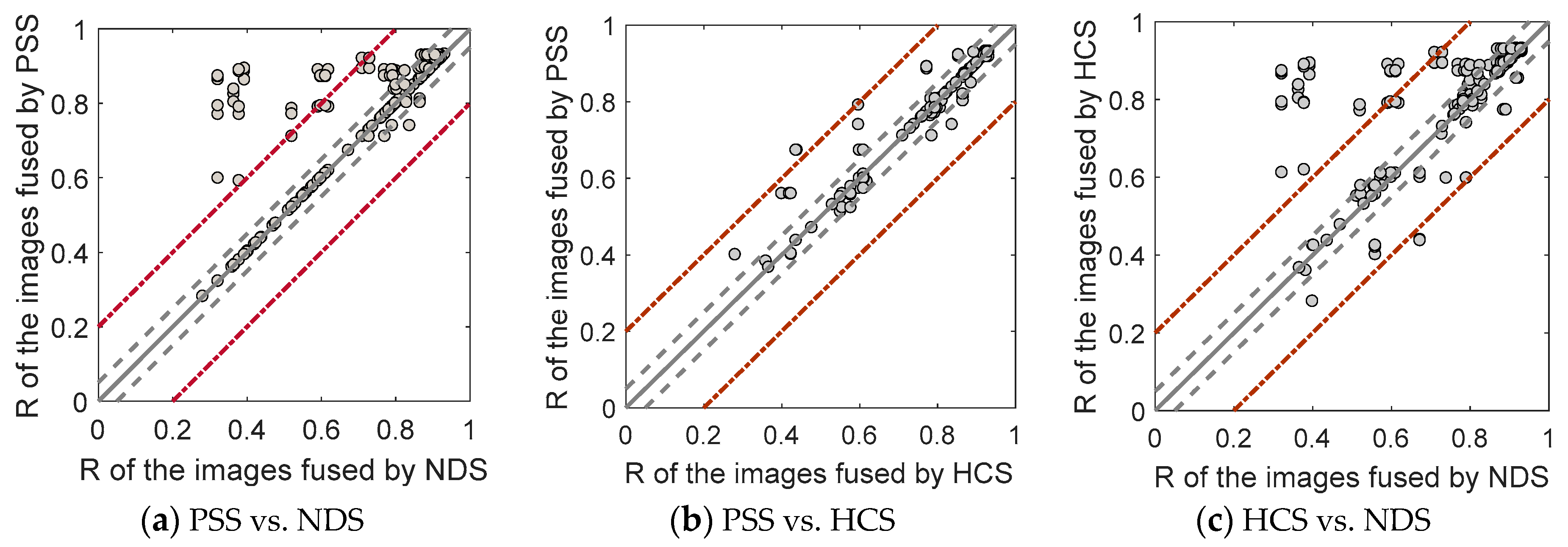
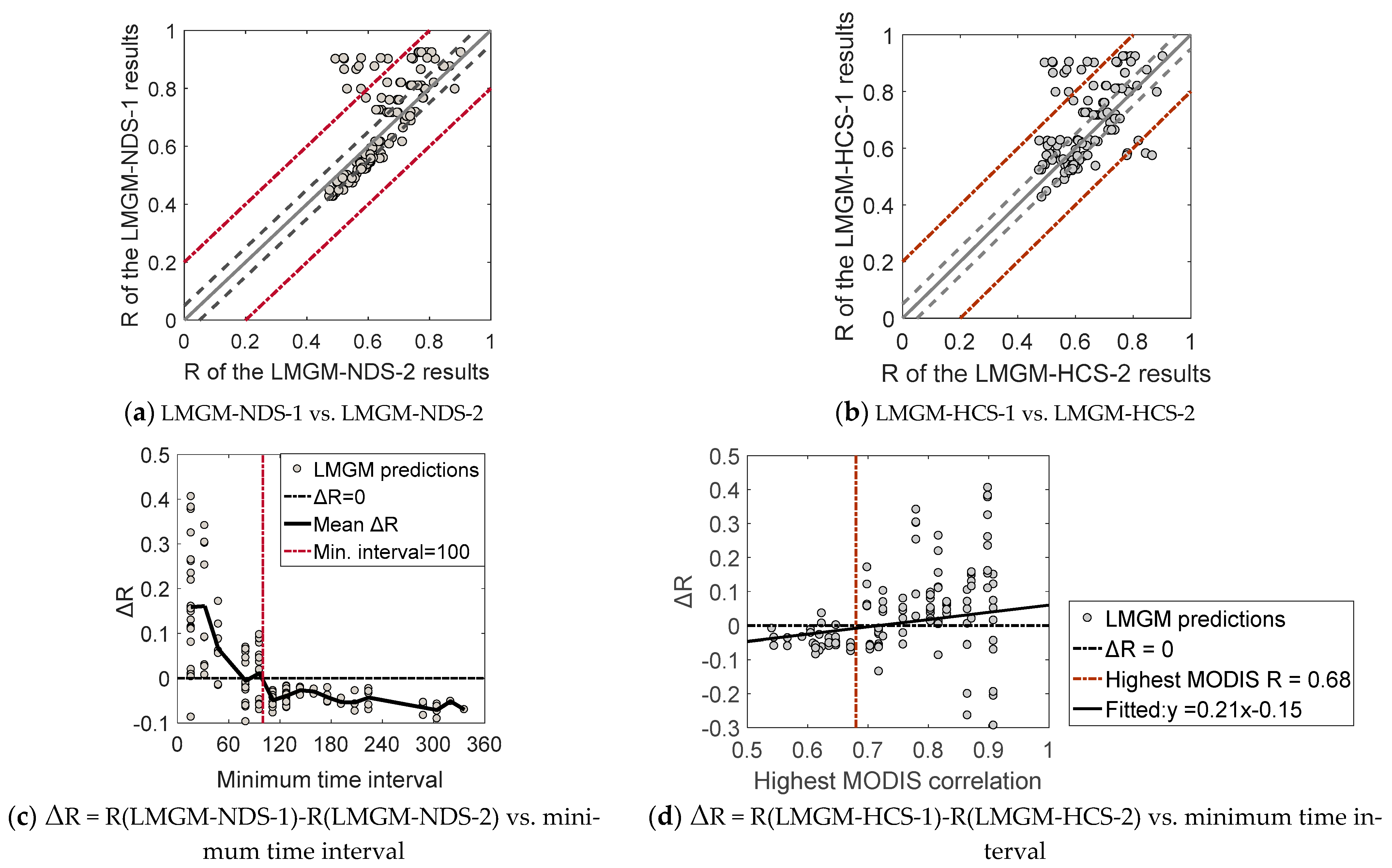
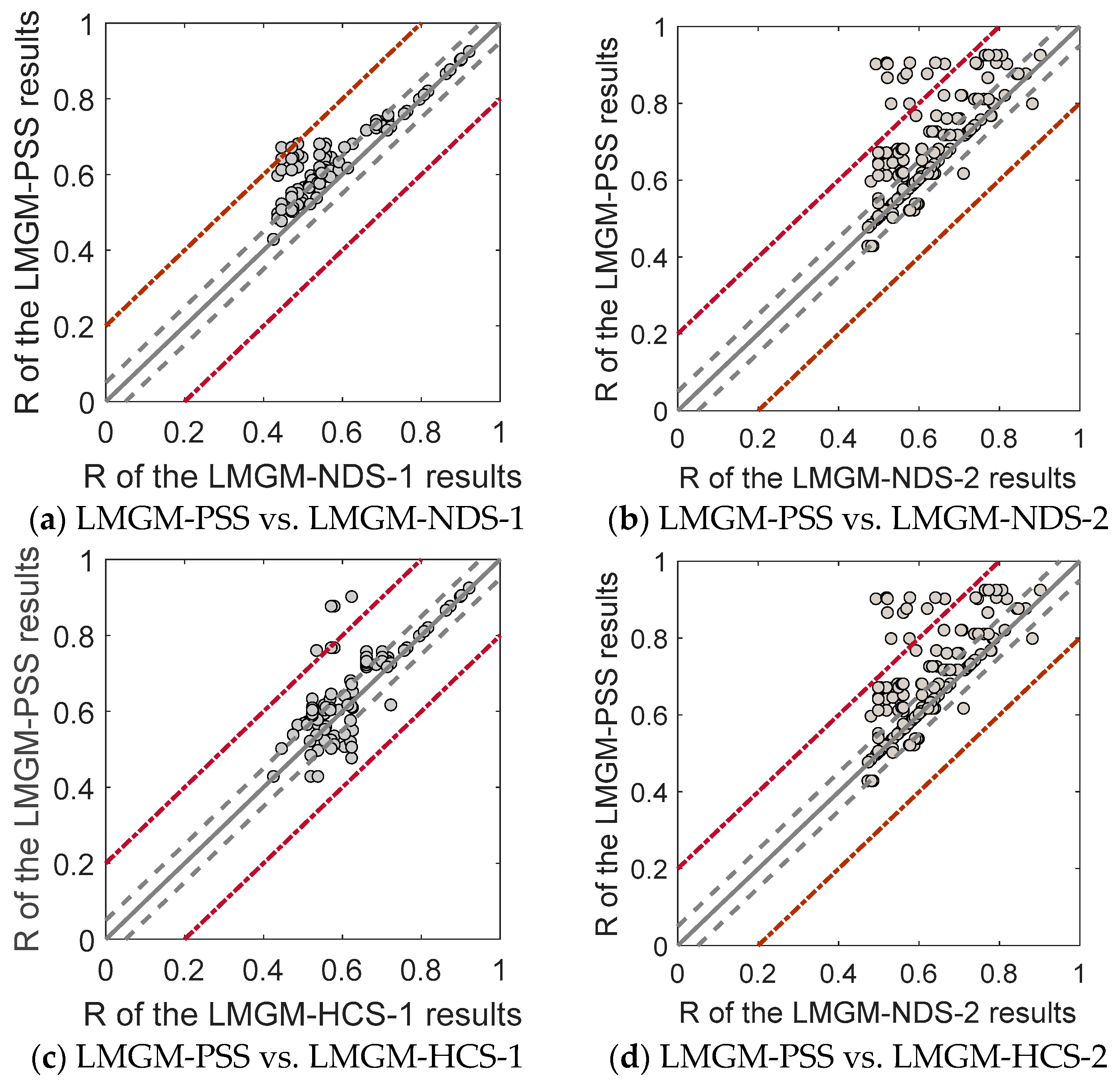
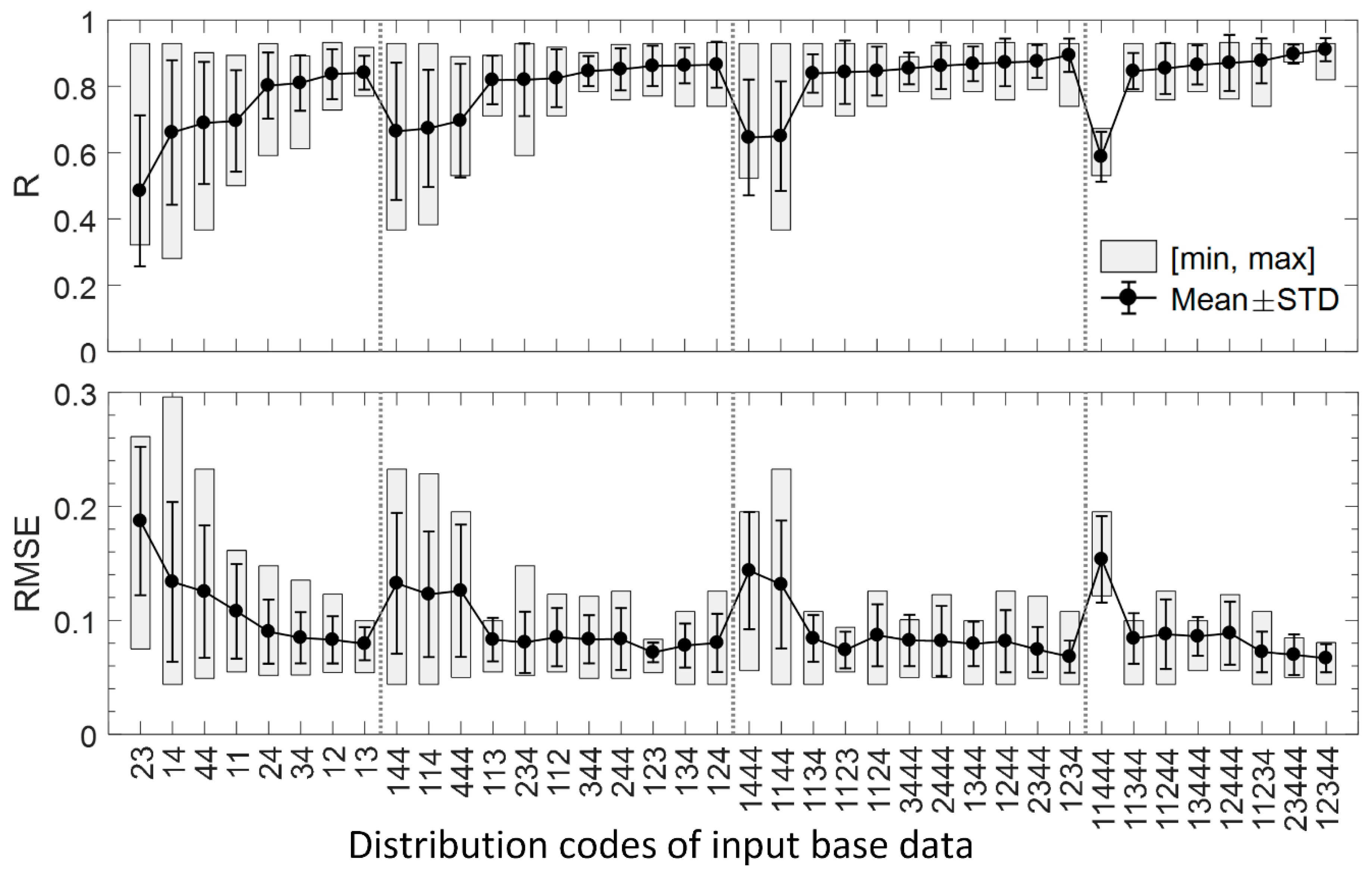
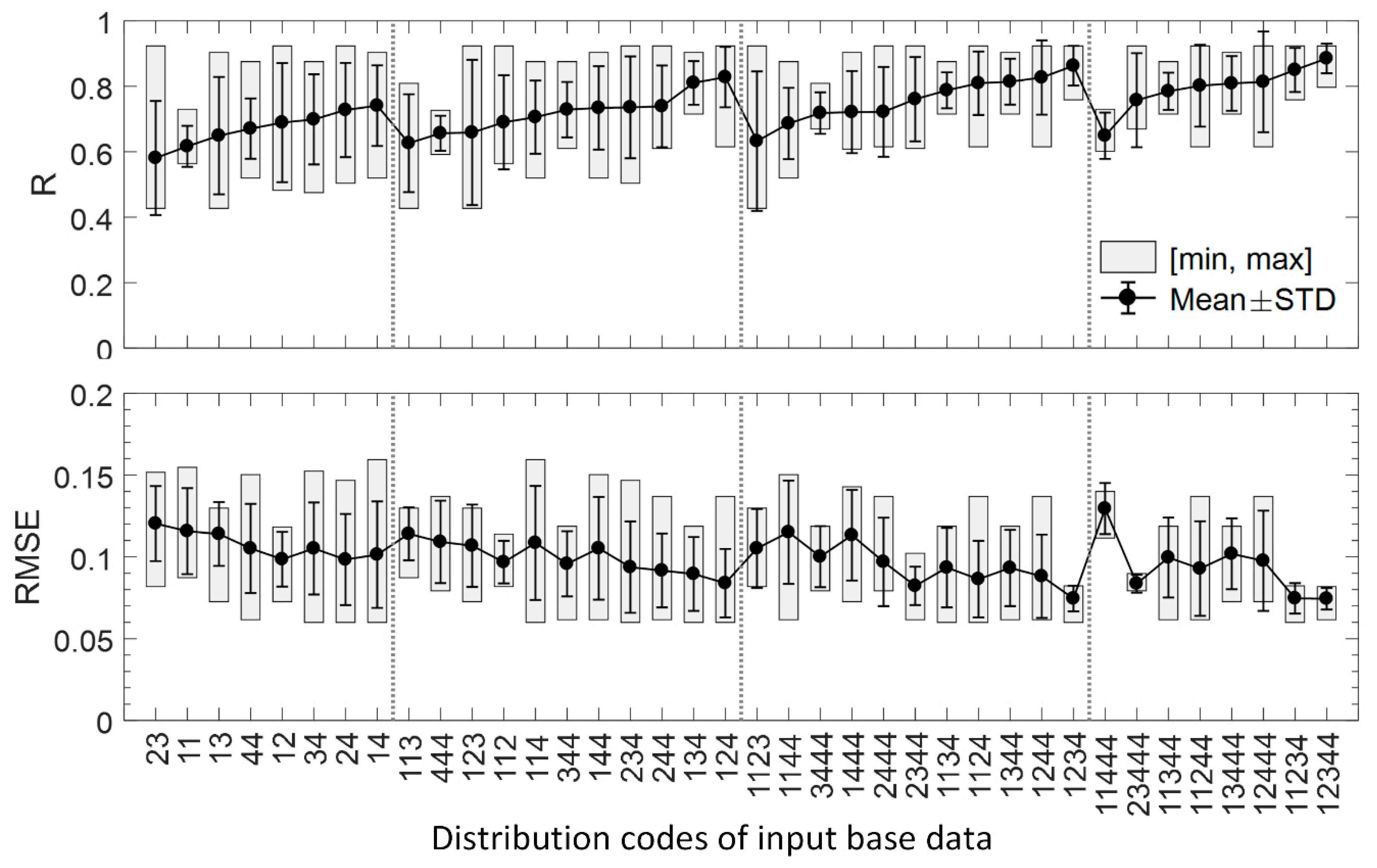
| Path/row No. | 126/035 | 126/036 | 126/037 | 127/035 | 127/036 | 127/037 | 128/035 | 128/036 | 128/037 | |
|---|---|---|---|---|---|---|---|---|---|---|
| Year | 2013 | 8 1 | 7 | 4 | 4 | 6 | 3 | 3 | 2 | 0 |
| 2014 | 8 | 2 | 3 | 11 | 8 | 1 | 5 | 5 | 2 | |
| 2015 | 6 | 3 | 2 | 3 | 2 | 1 | 4 | 3 | 1 | |
| 2016 | 3 | 2 | 1 | 5 | 4 | 3 | 2 | 4 | 0 | |
| 2017 | 7 | 4 | 5 | 5 | 4 | 1 | 8 | 4 | 2 | |
| 2018 | 6 | 4 | 3 | 3 | 3 | 2 | 6 | 5 | 0 | |
| 2019 | 7 | 4 | 4 | 5 | 7 | 3 | 3 | 1 | 0 | |
| Average | 6.6 | 3.7 | 3.1 | 5.1 | 4.9 | 2 | 4.4 | 3.4 | 0.7 | |
| Weights | Stage of Prediction Date | |||
|---|---|---|---|---|
| Stage of base date | 1 | 2 | 3 | 4 |
| 1 | 1.00 | 0.50 | 0.25 | 0.75 |
| 2 | 0.50 | 1.00 | 0.75 | 0.25 |
| 3 | 0.25 | 0.75 | 1.00 | 0.50 |
| 4 | 0.75 | 0.25 | 0.50 | 1.00 |
Publisher’s Note: MDPI stays neutral with regard to jurisdictional claims in published maps and institutional affiliations. |
© 2021 by the authors. Licensee MDPI, Basel, Switzerland. This article is an open access article distributed under the terms and conditions of the Creative Commons Attribution (CC BY) license (http://creativecommons.org/licenses/by/4.0/).
Share and Cite
Wang, Y.; Xie, D.; Zhan, Y.; Li, H.; Yan, G.; Chen, Y. Assessing the Accuracy of Landsat-MODIS NDVI Fusion with Limited Input Data: A Strategy for Base Data Selection. Remote Sens. 2021, 13, 266. https://doi.org/10.3390/rs13020266
Wang Y, Xie D, Zhan Y, Li H, Yan G, Chen Y. Assessing the Accuracy of Landsat-MODIS NDVI Fusion with Limited Input Data: A Strategy for Base Data Selection. Remote Sensing. 2021; 13(2):266. https://doi.org/10.3390/rs13020266
Chicago/Turabian StyleWang, Yiting, Donghui Xie, Yinggang Zhan, Huan Li, Guangjian Yan, and Yuanyuan Chen. 2021. "Assessing the Accuracy of Landsat-MODIS NDVI Fusion with Limited Input Data: A Strategy for Base Data Selection" Remote Sensing 13, no. 2: 266. https://doi.org/10.3390/rs13020266
APA StyleWang, Y., Xie, D., Zhan, Y., Li, H., Yan, G., & Chen, Y. (2021). Assessing the Accuracy of Landsat-MODIS NDVI Fusion with Limited Input Data: A Strategy for Base Data Selection. Remote Sensing, 13(2), 266. https://doi.org/10.3390/rs13020266




